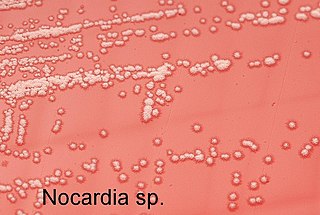
Brain abscess is an abscess caused by inflammation and collection of infected material, coming from local or remote infectious sources, within the brain tissue. The infection may also be introduced through a skull fracture following a head trauma or surgical procedures. Brain abscess is usually associated with congenital heart disease in young children. It may occur at any age but is most frequent in the third decade of life.

The rifamycins are a group of antibiotics that are synthesized either naturally by the bacterium Amycolatopsis rifamycinica or artificially. They are a subclass of the larger family of ansamycins. Rifamycins are particularly effective against mycobacteria, and are therefore used to treat tuberculosis, leprosy, and mycobacterium avium complex (MAC) infections.
Nocardiosis is an infectious disease affecting either the lungs or the whole body. It is due to infection by a bacterium of the genus Nocardia, most commonly Nocardia asteroides or Nocardia brasiliensis.

Edmond Isidore Etienne Nocard, was a French veterinarian and microbiologist, born in Provins.

Nocardia is a genus of weakly staining Gram-positive, catalase-positive, rod-shaped bacteria. It forms partially acid-fast beaded branching filaments. It contains a total of 85 species. Some species are nonpathogenic, while others are responsible for nocardiosis. Nocardia species are found worldwide in soil rich in organic matter. In addition, they are oral microflora found in healthy gingiva, as well as periodontal pockets. Most Nocardia infections are acquired by inhalation of the bacteria or through traumatic introduction.
Buffered charcoal yeast extract (BCYE) agar is a selective growth medium used to culture or grow certain types of bacteria, particularly the Gram-negative species Legionella pneumophila. It has also been used for the laboratory diagnosis of Acanthamoeba keratitis, Francisella and Nocardia.
Nocardia brasiliensis is a species of Nocardia. As with most members of Actinomycetota, they contain high guanine and cytosine content. It can cause nocardiosis.

The Nocardiaceae are a family of aerobic, non-fastidious, high G+C, Gram-positive actinomycetes that are commonly found in soil and water. Members of this family have been isolated from Antarctic soils. Nocardiaceae present coccobacilli, filamentous or, rarely, fragmented and palisading forms, and filamentous species grow in a branching morphological pattern similar to fungal hyphae.
Nocardia veterana is a species of bacteria from the genus Nocardia that has been isolated from human bronchial lavage.

An oxacephem is a β-lactam molecule similar to a cephem, but with an oxygen substituted for the sulfur. They are synthetic compounds not seen in nature, generally used as β-lactam antibiotics. Examples include Latamoxef and Flomoxef.

Nocardicin A is a monocyclic β-lactam antibiotic included in the monobactam subclass. It is obtained from the fermentation broth of a strain of actinomycetes Nocardia uniformis subsp. tsuyamenensis as a metabolic product catalyzed by the enzyme nocardicin-A epimerase. It is stereochemically and biologically related to penicillin and cephalosporins.

Nocardia asteroides is a species of Nocardia. It can cause nocardiosis, a severe pulmonary infection in immunocompromised hosts.
Nocardia farcinica is a species of bacteria, once thought to be associated with farcy, and a member of the genus Nocardia. This species is very similar in phenotype to Nocardia asteroides, to the degree that some isolates of N. asteroides were later found to be Nocardia farcinica.
Vittore Benedetto Antonio Trevisan de Saint-Léon was an Italian botanist who specialized in cryptogamic flora.
Nocardia ignorata is a species of bacteria and a member of the genus Nocardia. Its type strain is IMMIB R-1434T.
Amycolatopsis rifamycinica is a species of Gram-positive bacteria in the genus Amycolatopsis. It produces the rifamycin antibiotics, which are used to treat mycobacterial diseases such as tuberculosis and leprosy. The type strain of Amycolatopsis rifamycinica has been reclassified several times. When it was first isolated from a French soil sample in 1957, it was identified as Streptomyces mediterranei. In 1969, the species was renamed Nocardia mediterranei because its cell wall was thought to resemble that of Nocardia species. The species was renamed Amycolatopsis mediterranei in 1986 after finding that it is not susceptible to Nocardia phage and has a cell wall that lacks mycolic acid. Finally, in 2004, it was determined that strain DSM 46095 represented a new species, independent of Amycolatopsis mediterranei, based on 16S ribosomal RNA sequencing. The new species was named Amycolatopsis rifamycinica.
Nocardia aurantiaca is a species of bacteria from the genus Nocardia that has been isolated from soil in Thailand.
NotI is a restriction enzyme isolated from the bacterium Nocardia otitidis.
Prauserella rugosa is a bacterium from the genus Prauserella which has been isolated from the rumen of cattle.






